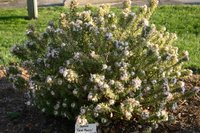There are more choices out there in the tree and shrub world than what Lowe's (insert any big box store name here) offers for sale in its stores. There -- I said it. I can't stand Lowe's. I can't stand Walmart. You will never find me there -- except when I HAVE to buy my daughter a new dance outfit the VERY night she started her dance class and WM was the only choice at 8pm.
The
 re are so many different, unique, beautiful, trees and shrubs in the world! And many of you end up buying Bradford pears, Taxus, dogwoods, just whatever might be in stock at the store.
re are so many different, unique, beautiful, trees and shrubs in the world! And many of you end up buying Bradford pears, Taxus, dogwoods, just whatever might be in stock at the store. 
Well, let me name a few of my favorites and show you a few you're missing: Fringetree, Sourwood (below left), Kentucky Coffeetree, Blue ash, Bald Cypress, Daphne (at right), Contorted Filbert, Buttonbush (at left), Serviceberry, Bottlebrush buckeye, Beautyberry, Fothergilla, Kousa dogwood, purple redbuds, white redbuds, wee
 ping redbuds, red-leafed redbuds to name a few.
ping redbuds, red-leafed redbuds to name a few.With the internet, we have no excuse for settling. Research your choices. Be a good consumer.
NC State University has a good website on various trees and shrubs with pictures.

